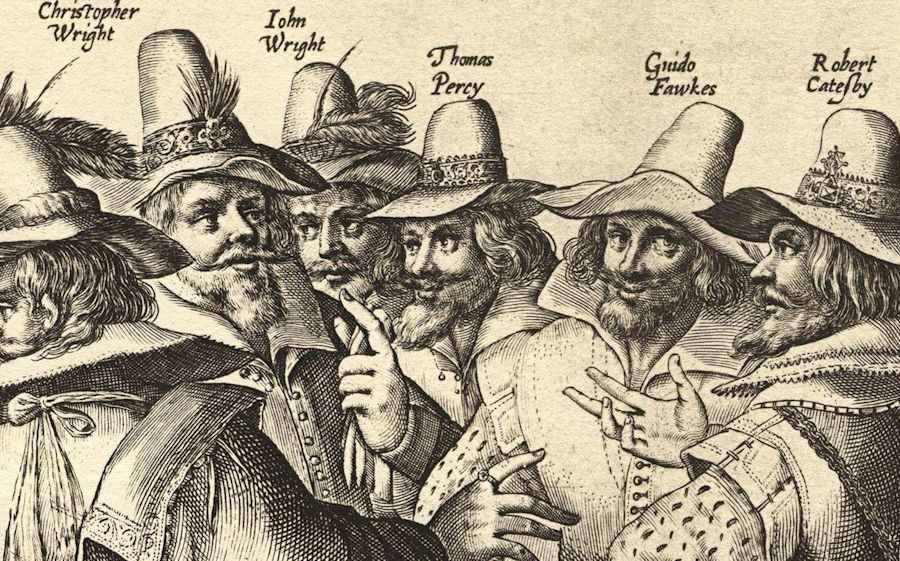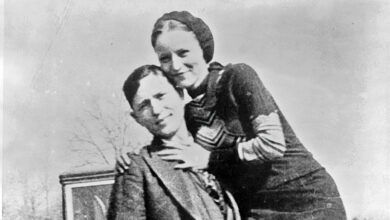
Podcast: Play in new window | Download
The Gunpowder Plot, the attempt by thirteen young men to blow up the Houses of Parliament, is remembered and commemorated each November 5th. Guy Fawkes was the most famous of the group, but perhaps only because he was the one caught. A different man was the actual ringleader.
But what led these young men to attempt such a dramatic act of treason? What did they hope to accomplish by their actions?
A bit of background is in order. During the years in which Queen Elizabeth I reigned, the Catholics in England were persecuted for their faith. One of the reasons for this was the attempted invasion by the Spanish using an Armada of ships, and invasion which had the backing of the Pope. Had it not been for bad weather the Spanish Armada might have been successful. Catholic Masses in England were held in secret or Catholics would attend Protestant churches. All as a result of the queen’s hatred of Catholicism.
Upon her death in 1603, Elizabeth’s cousin, James, ascended to the throne, and Catholics throughout the country were hopeful that things would change for them, as James had had a Catholic mother – Mary, Queen of Scots – and a Catholic wife as well. The feeling in the country was that he would be more sympathetic towards them. After all, his own mother had been forced to abdicate; surely he would understand what it meant to be persecuted and outcast.
This idea did not come to pass, however. Instead, King James ordered all Catholic priests out of the country, as well as instructing Parliament to remove certain rights from Catholics.
Led by Robert Catesby, a Warwickshire businessman, the band of thirteen decided that the only way to get anything to change was to resort to violence. They hatched a plan to destroy the Houses of Parliament on state opening day which was set for 5 November 1605, with 36 barrels of gunpowder.
In so doing, they would also kill King James and perhaps the Prince of Wales as well. The Members of Parliament who were passing the laws against the Catholics would also perish. Then, James’ daughter, also called Elizabeth, could be placed on the throne and as she was Catholic, they could finally have a sympathetic person as ruler.
The kegs of gunpowder were obtained and stored under the House of Lords, the upper chamber of Parliament. The barrels were snuck in quite easily, as the young men had rented a house right next to the Parliament buildings and then later the storage room under the House itself.
As the planning progressed, some in the group started to express concern that the explosion would also harm the innocent and uninvolved, especially when it came to those sympathetic to the cause. One of the members, thought to be Francis Tresham, wrote to Lord Monteagle (his brother-in-law) to advise him of the plot and to not come to Parliament on 5 November.
The letter was forwarded to the king, who assembled his guards and tasked them with preventing the attack. The guards entered Parliament and swept through, looking for the conspirators. Guy Fawkes, a man from Yorkshire, was in the basement under the House of Lords next to the gunpowder with a fuse in hand when he was captured. He had been chosen to be the one to carry out the difficult task of actually lighting the fuse because of his previous battle experience in Spain.
He was taken to the Tower of London and tortured. After two days, Fawkes confessed to the plot. He was later convicted of treason and was hanged on 31 January 1605 as an example to the others of what fate awaited them. The delays in dealing with Fawkes though gave time for the others to escape.
Catesby was later tracked down, shot, and killed by the king’s men when he was cornered at Holbeche House in Staffordshire. Those who died with him that day were later exhumed and beheaded by the king’s guards.
Bonfires were lit around the city on the evening of 5 November to signal the fact that the king was safe. England continues to celebrate on that day, now called Bonfire Night, with fireworks, bonfires, and effigies of Guy Fawkes being burned in those fires.
Today we would of course consider their efforts to be an act of terrorism, despite the gunpowder being old and therefore not very effective, thus rendering the plot a failure. The plot also backfired. It caused King James to crack down even further, getting laws with even greater restrictions passed to remove voting rights, among other things. It was 200 years before those laws were overturned.
There are many lasting effects of the Gunpowder Plot. To this day, the Queen only comes into Parliament one day a year, on the day designated as The State Opening of Parliament. Before her arrival, the Yeomen of the Guard sweep the Palace of Westminster to check that it is indeed safe, and if it is, then she is allowed to enter.
Children today continue to be taught the rhyme, “Remember, remember, the 5th of November; gunpowder, treason and plot; I see no reason why gunpowder, treason; should ever be forgot.” With bonfires and fireworks still as popular as ever on the 5th of November, over 400 years after the event, it seems indeed that it never will be forgot.
Podcast: Play in new window | Download





